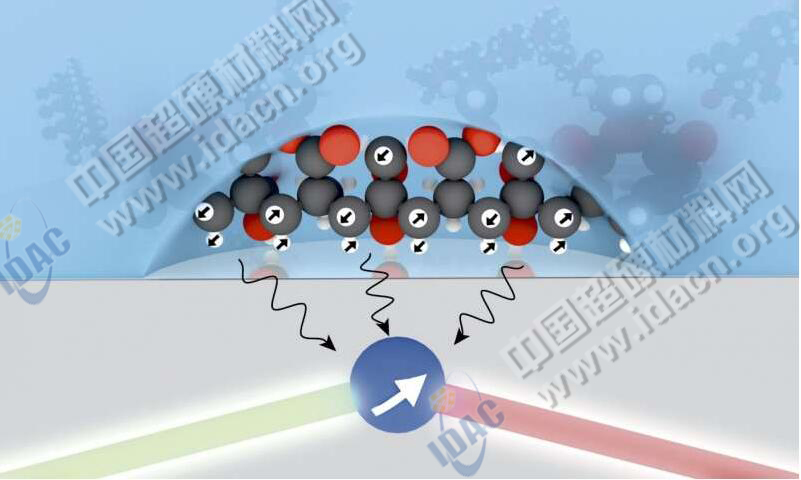Abstract The internal (light grey) nitrogen vacancy (dark blue) quantum probe of diamond performs nanoscale nuclear magnetic resonance (NMR) operation on molecular hydrogen on the diamond surface. The green laser controls the quantum state of the probe and adjusts it to the resonant frequency of the target nuclear spin. Probe to the core of a hydrogen atom...

The internal (light grey) nitrogen vacancy (dark blue) quantum probe of the diamond performs a nanoscale nuclear magnetic resonance (NMR) operation on the molecular hydrogen on the diamond surface. The green laser controls the quantum state of the probe and adjusts it to the resonant frequency of the target nuclear spin. The probe reacts to the nuclear spin of the hydrogen atom and provides a direct measurement by the emitted red light. Image courtesy of David A. Broadway/cqc2t.org
Recently, the University of Melbourne research team proposed a non-invasive molecular nuclear spin detection method, providing a new scientific tool for new materials and biotechnology.
Many studies in the fields of medicine and biology often require nuclear magnetic resonance (NMR) spectroscopy, but the problem of spatial resolution has always been a technical bottleneck, and NMR spectroscopy usually requires a strong microwave electric field. In response to these problems, the research team led by Professor Lloyd Hollenberg of the University of Melbourne proposed a new method for nano-scale microwave-free NMR operation using quantum probes. The study was published in the journal Nature Communications.
Hollenberg, director of the Center for Quantum Computing and Communication Technology (CQC2T) at the University of Melbourne, said that this new type of quantum probe can perform NMR detection on miniature samples, which is not possible with conventional machines; moreover, new quantum probe technology The application of the microwave electric field is not required, thereby avoiding the decomposition damage caused by the microwave electric field to the biological sample.
The purpose of NMR is to detect the magnetic signals of the nucleus that make up the molecule; however, the signal from the nuclear spin is very weak, and traditional NMR machines require millions of nuclear spins to detect the signal.
But quantum probes developed using diamond defects require only a few thousand spins to easily detect signals from nuclear spins.
Alastair Stacey, a postdoctoral researcher at CQC2T, said: The main problem with the large-scale NMR machines currently used is that the detection signal is very weak and the distance between the detection target and the measuring device is too large. This leads to two problems: First, the machine can only detect larger molecules, and the measurement accuracy is greatly reduced. The second is the need to contact the sample with powerful microwaves and magnetic fields. These invasive methods can affect or even destroy the biological pattern. ( Compile: China Superhard Materials Network )
Many studies in the fields of medicine and biology often require nuclear magnetic resonance (NMR) spectroscopy, but the problem of spatial resolution has always been a technical bottleneck, and NMR spectroscopy usually requires a strong microwave electric field. In response to these problems, the research team led by Professor Lloyd Hollenberg of the University of Melbourne proposed a new method for nano-scale microwave-free NMR operation using quantum probes. The study was published in the journal Nature Communications.
Hollenberg, director of the Center for Quantum Computing and Communication Technology (CQC2T) at the University of Melbourne, said that this new type of quantum probe can perform NMR detection on miniature samples, which is not possible with conventional machines; moreover, new quantum probe technology The application of the microwave electric field is not required, thereby avoiding the decomposition damage caused by the microwave electric field to the biological sample.
The purpose of NMR is to detect the magnetic signals of the nucleus that make up the molecule; however, the signal from the nuclear spin is very weak, and traditional NMR machines require millions of nuclear spins to detect the signal.
But quantum probes developed using diamond defects require only a few thousand spins to easily detect signals from nuclear spins.
Alastair Stacey, a postdoctoral researcher at CQC2T, said: The main problem with the large-scale NMR machines currently used is that the detection signal is very weak and the distance between the detection target and the measuring device is too large. This leads to two problems: First, the machine can only detect larger molecules, and the measurement accuracy is greatly reduced. The second is the need to contact the sample with powerful microwaves and magnetic fields. These invasive methods can affect or even destroy the biological pattern. ( Compile: China Superhard Materials Network )
Square Shower Drain,Shower Grates Drain,Square Gold Shower Floor Drain,Square Gold Floor Drain
Kaiping City Jinqiang Hardware Products Co.,Ltd , https://www.kimpowerdrain.com